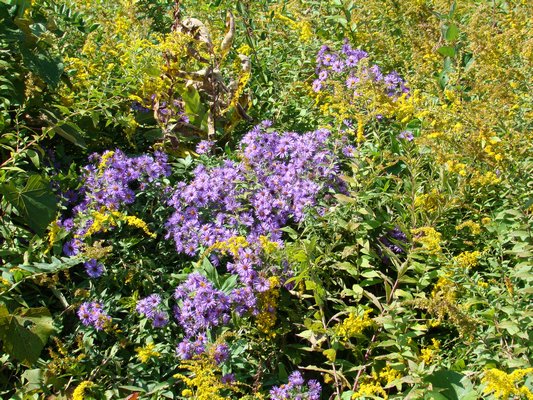

Last week we began looking at my recent affair with goldenrods and how they captivated me a few summers ago. This week I'll take a closer look at the genus Solidago and how it fits into our local landscape and gardens and one of the pitfalls in growing some varieties of this plant.Here are some of the more common goldenrods you may find being grown in this area, though not all are what we might call natives. One thing they do have in common is that you'll always find them growing in tough neighborhoods, places where most other perennials won't grow, and this should give you a hint as to their versatility.
The seaside goldenrod (Solidago sempervirens) is probably the most common form found on the East End. It produces a tight clump of narrow basal leaves that have a thick swollen texture, which is useful in storing water in the parched beach and sandy roadside environments where they're found. This plant is extremely adaptable and can be transplanted to a flower border or other location without difficulty, but again, late winter or early spring is the best time to move and divide them—and please don't dig them from the dunes.
When planting this variety in the garden, be careful not to put it in soil that is too rich or too wet, and don't fertilize it. Either situation will cause it to grow in a floppy habit, and flowering will be much reduced. In fact, virtually all goldenrods, possibly with the exception of some of the new hybrids that came on the market in the past decade, will prefer poor soil and low fertility situations.
The blue-stemmed goldenrod (S. caesia) grows and flowers in light shade, making it suitable for the edge of a woodland garden or lightly shaded border. The flowers appear in September in elongated clusters along the 2-foot-long stems.
Solidago canadensis can grow from 1 to 4 feet tall and has very narrow, lanceolate (lance-shaped) leaves that can be 5 inches long. The flowers are characteristically yellow with a branching habit. This may be one of the showiest goldenrods and is somewhat rare on Long Island, but you see it with more frequency as you travel from Westchester north.
And speaking of north … if you should travel to the mountains, watch out for S. cutleri, the only goldenrod that is evergreen. It's usually found on mountaintops in the Catskills and Adirondacks and grows only from 3 to 12 inches tall. It won't do well at the seaside, but if you can get some seed or a clump you may want to give it a try in a breezy and exposed rockery or those cold and sandy spots of the Westhampton area.
Solidago bicolor is the exception that proves the rule: a white goldenrod. Its common name is silver-rod, suggesting the color of the flowers. The ray flowers are a creamy white and the disc flowers are yellow. This species is biennial, flowering the second year and then dying, so save some of the seed. It's not a particularly striking plant until you find it and realize it's a goldenrod.
Anise scented goldenrod (S. odora) has this common name because of its fragrant foliage, which can be used for an herbal tea. The plant grows best in full sun and will tolerate a moderately rich soil. This one is not a spreader.
And speaking of spreaders, if you decide to plant goldenrods, give them plenty of room to sprawl or be willing to contain and control them. Many species seem to be stoloniferous, with their roots stretching out laterally a bit farther each year, expanding their mass.
Solidago rugosa Fireworks" is one of the better ornamental varieties but it does like to sprawl. Flowering from late September well into October, it tolerates light shade and provides bright yellow flowers on tall and stiff stems, so it also makes a nice cut flower. I planted three small plants a foot apart and the family now, a decade later, covers an area of nearly 50 square feet. It's easy to tame by pulling out plants from the peripheral growth in the spring, just a few minutes of work.
On the other end of the spectrum is Solidago canadensis "Crown of Thorns." I've had this in a somewhat shady portion of my long perennial border since 2008. I started with three plants that were planted in a 1-foot triangle and in eight years they have remained pretty much in the same spot, give or take a few inches. This variety flowers among the earlier goldenrods and out here you can expect it to start flowering in late June and continue until mid to late October. It's a great plant for pollinators and seems to attract more than its share of honeybees.
One other consideration when using these plants in the garden are the combinations of Solidago with other plants. One combo that Mother Nature seems fond of is the yellow goldenrod with the blues and purples of the fall asters. Both being tall and stiff and in the same plant family, they are a natural duo that you'll see in both planned gardens and nature's random mix.
A combination that you rarely see are the white flowers of Queen Anne's lace (Daucus carota) with the goldenrods. Both seem to be colonizing plants but they rarely grow in the same spot unless encouraged. So for the early Solidagos you can have a mix of white and yellow and for the later bloomers the blues and yellows. You can accomplish the white mix by collecting Queen Anne's lace seed now through the rest of the summer and scattering it in the same area where you plan on planting or where the goldenrods already exist. Asters are best planted or moved in early spring.
In 1993 the Chicago Botanic Garden began evaluating a number of goldenrods to determine which would do best in Midwest gardens. Over a five-year period, more than 25 varieties were trialed, and while their zone 5b conditions are a bit different from ours, you may want to look at the trial results and evaluations as a rough guide to help in your selections. The information includes flower color, percentage of flower cover at peak bloom, blooming period, height, width, disease-resistance and susceptibility to winter damage. You can read the entire evaluation and report at http://goo.gl/ZwwqfQ.
Fall in love … and keep growing.
"
 More Posts from Andrew Messinger
More Posts from Andrew Messinger